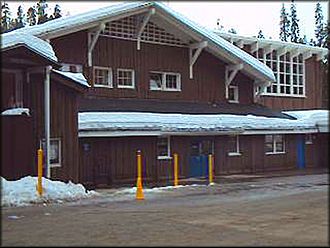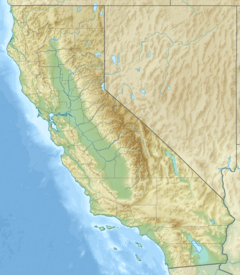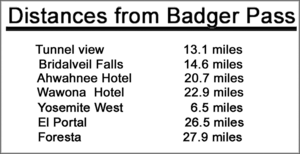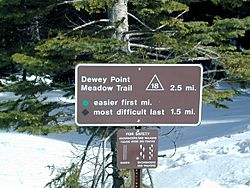Badger Pass Ski Area facts for kids
Quick facts for kids Badger Pass Ski Area |
|
|---|---|

The historic Badger Pass Ski Lodge
|
|
| Location | Yosemite National Park, California |
| Nearest city | Mariposa, California |
| Coordinates | 37°39′43″N 119°39′49″W / 37.66194°N 119.6636°W |
| Vertical | 800 ft (240 m) |
| Top elevation | 8,000 ft (2,400 m) |
| Base elevation | 7,200 ft (2,200 m) |
| Skiable area | 90 acres (36 ha) |
| Runs | 10 total |
| Longest run | 0.4 mi (640 m) |
| Lift system | 5 lifts: 1 triple chair 3 double chairs 1 surface lift |
| Lift capacity | 6,800 skiers/hr |
| Terrain parks | 1 |
| Snowfall | 300 in (7.6 m) |
| Night skiing | None |
| Website | [1] |
Badger Pass Ski Area is a fun place to ski and snowboard inside Yosemite National Park. It's special because it's one of only a few ski areas with lifts located within a US National Park. You can find it in the southern part of Yosemite, and you get there by driving on Glacier Point Road.
When there's a lot of snow, Glacier Point Road closes to cars at Badger Pass. The rest of the road then becomes a long trail perfect for cross-country skiing and snowshoeing.
Contents
Where is Badger Pass?
Badger Pass sits at about 7,200 feet (2,200 m) high, where the main buildings are. If you take the ski lifts to the top, you'll reach an elevation of 8,000 feet (2,400 m).
This ski area covers about 90-acre (36 ha) and has 10 ski runs. There are 5 lifts to take you up the mountain. You can enjoy downhill skiing, snowboarding, and even snow tubing here. If you're new to skiing or want to get better, there are training areas with instructors ready to help. A special snow tubing area is roped off for safety, so skiers don't accidentally enter it.
Besides downhill fun, Badger Pass is also famous for its amazing cross-country skiing and snowshoe trails. There are over 84 miles (135 km) of trails that let you explore many beautiful parts of Yosemite in winter. You can even stay overnight in two special huts for longer trips into the snowy wilderness.
A Look Back: History of Winter Sports
The story of winter sports in Yosemite National Park is quite interesting. After the Ahwahnee Hotel was built in the 1920s, Yosemite opened its first ski school in 1928. A Swiss ski expert named Jules Fritsch was one of the first instructors. Many people believe this was the first ski school in California!
In 1927, a four-track toboggan slide was built near Camp Curry. Dr. Donald Tresidder, who led the company running Yosemite's hotels and services, saw how much visitors loved winter sports. He quickly started the Yosemite Winter Club. With their help, a small ski hill and a ski jump were built in 1928.
Dr. Tresidder even tried to get Yosemite chosen for the 1932 Winter Olympics. While another location was picked, it made people even more excited about winter sports in Yosemite. Tresidder realized that Yosemite needed better facilities for skiing.
In 1933, the first ski lift was built, not near the hotel, but at Badger Pass. The first slalom ski race in California also took place at Badger Pass that same year. However, getting to Badger Pass was hard because of the roads, which slowed down new developments.
A big change happened when the Wawona Tunnel was finished in 1933. This tunnel made it much easier and faster to get to Yosemite Valley. Then, in 1935, Glacier Point Road to Badger Pass opened. Soon after, Yosemite's first ski lodge was built. By the end of that winter season, over 25,000 skiers had visited Badger Pass!
In 1936, the first ski lift in the Western United States was installed. It was called the "Upski" and nicknamed the "Queen Mary." This large sled could carry six skiers up the hill on a cable. Over time, winter activities in the main valley faded, and skiers focused more on Badger Pass as the roads improved.
For a few years, starting in 2016, Badger Pass was called "Yosemite Ski & Snowboard Area." This was due to a legal issue over names. But in 2019, the problem was solved, and the resort proudly got its historic name, Badger Pass, back.
Badger Pass Today
Today, Badger Pass Ski Area is a popular spot for both downhill skiing and snowboarding. The National Park Service works with a company called Aramark to run it. A main feature is the beautiful Badger Pass Day Lodge. Inside, you'll find the Snowflake Room, where you can relax and watch skiers on the 10 downhill runs and 5 lifts. The Lodge is only for day use and doesn't have overnight rooms anymore.
You can find food and an activities desk on the lower level of the lodge. There are also several ski schools that teach both beginners and advanced skiers.
If you love exploring the outdoors, cross-country skiing is a big draw here. You can find instructors and guides to help you. Yosemite offers 22 miles (35 km) of groomed cross-country tracks and 90 miles (145 km) of marked trails. There are also over 9 miles (14 km) of special skiing lanes along a groomed part of Glacier Point Road. You can rent cross-country ski equipment at the lodge.
A popular trip is the 21-mile (34 km) round-trip cross-country ski to Glacier Point. The views of Half Dome in winter from there are amazing! You can even see webcams of these views online. There's also a guided ski trip to the Glacier Point Ski Hut for an overnight adventure, offering incredible snowy views.
Badger Pass also hosts the annual Yosemite Nordic Holiday every February. This event features a series of cross-country ski races.
Images for kids















